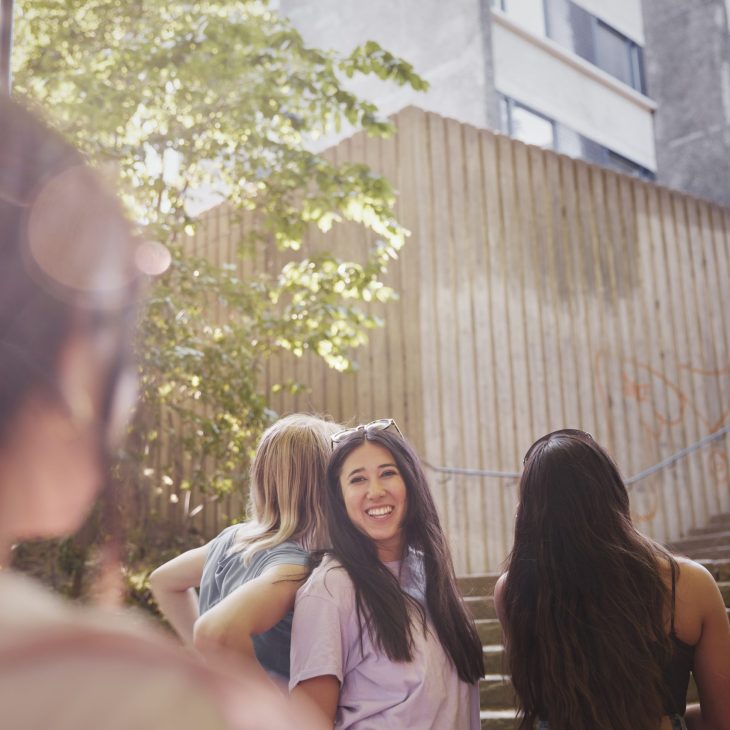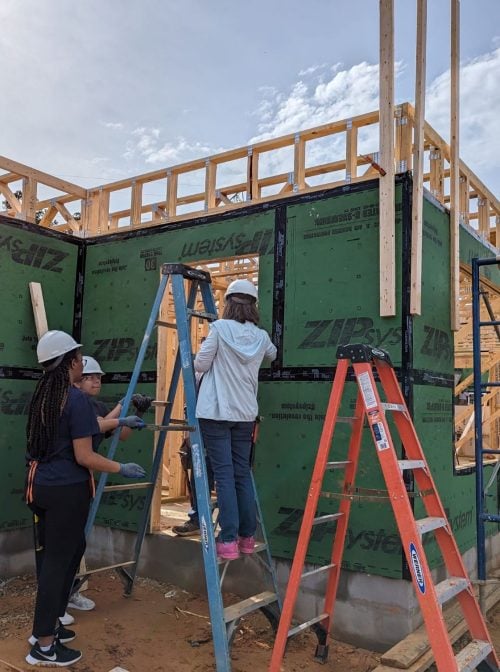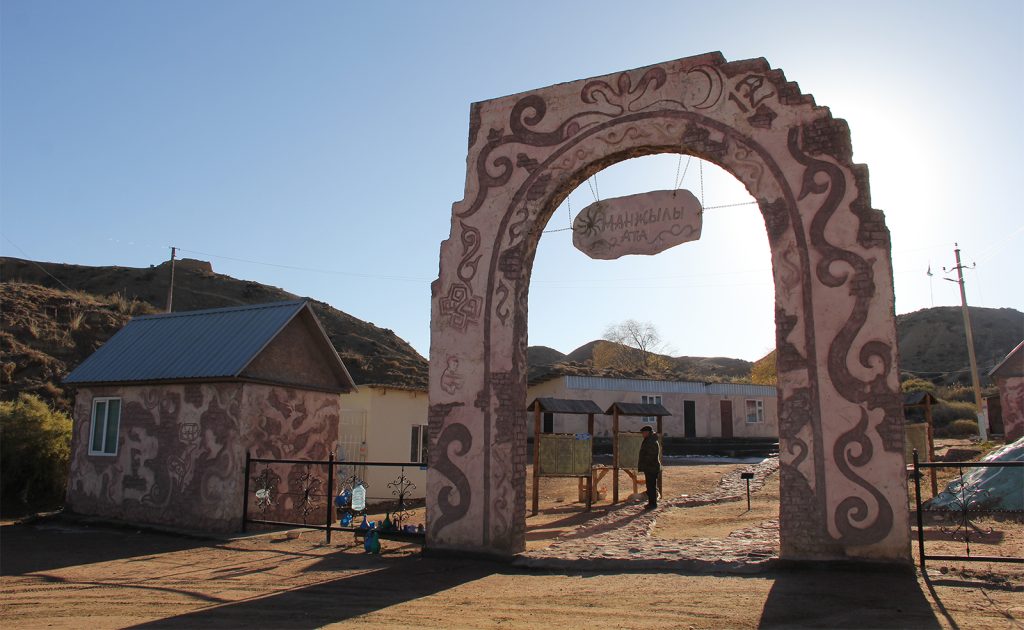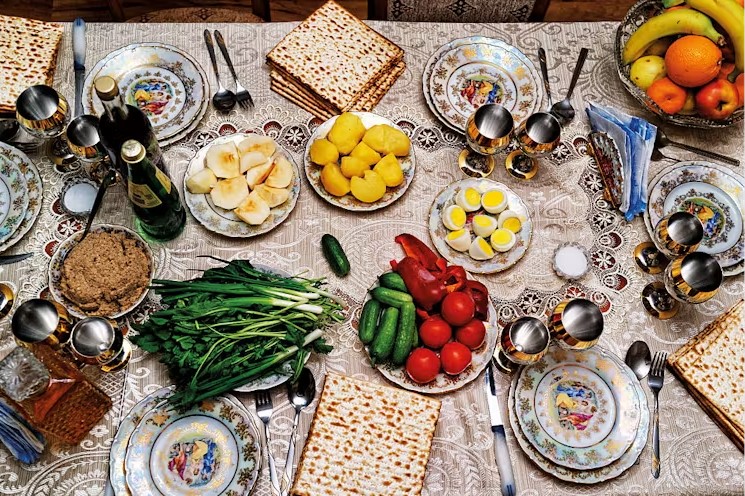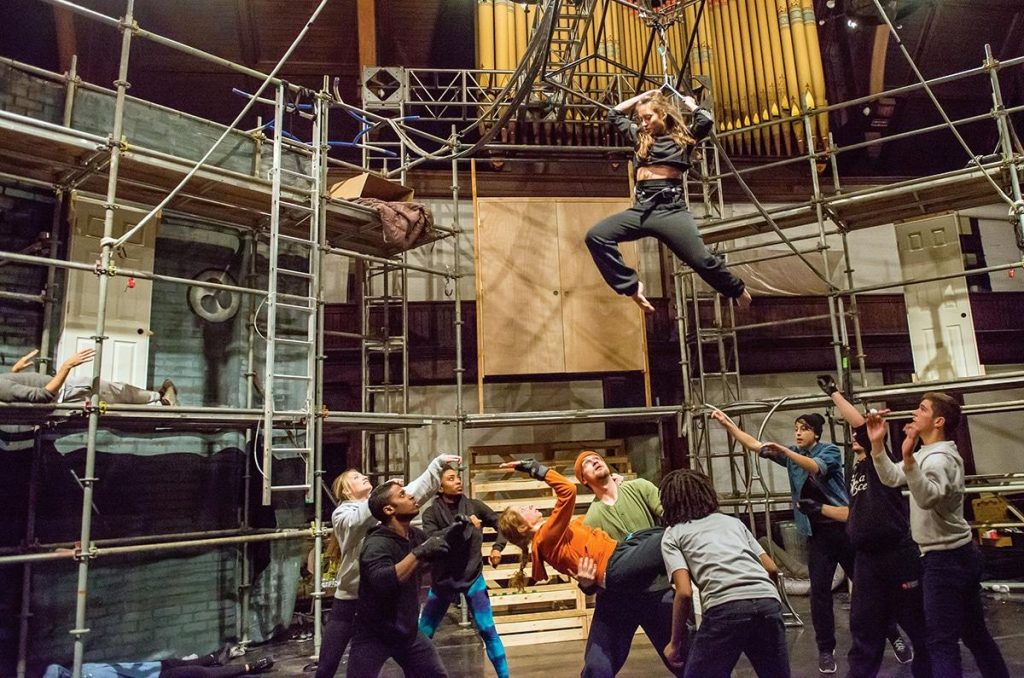Forty-eight people gathered on a sunny 50-degree February morning on a Habitat build site in Chapel Hill, North Carolina.
Regular and first-time Habitat for Humanity volunteers participated in a typical Saturday build with a particular focus, a new effort called Building Pride.
Amidst coffee, fruit, and muffins, volunteers stood around the covered picnic tables in groups of two or three and leaned into small talk under a clear blue sky and beaming sun. I had the chance to learn from and contribute to a conversation on finding aluminum-free but effective deodorant. The construction crew leaders leaned against the sheds, and Ansel Prichard, Volunteer Engagement Manager, began to welcome everyone to the site. With sincere gratitude for volunteers’ time, a few funny quips that got everyone laughing, and a clear commitment to Habitat’s mission, Ansel told volunteers – including the future homeowners putting in their sweat equity work hours – that from the moment the foundation is laid until the final piece of siding is secured, volunteers are part of building each Habitat home every step of the way.
This day’s build was unique, the second Building Pride event Orange County Habitat had ever done. Building Pride started when Orange County Habitat became a Team Up Project site, one of Habitat for Humanity’s ten sites nationwide during the initiative’s pilot year (May 2023 – March 2024). Orange County Habitat regularly brings together a diversity of ages, races, religions, genders, and economic statuses – all remarkable and essential. When joining Team Up, Orange County Habitat had two transgender employees, and the executive director encouraged the Team to focus on building bridges with the LGBTQ+ community of the research triangle. The staff was learning more about the pressing need in their community and wanted to be part of the solution.
The building occurred in Weaver’s Grove, a remarkable and ambitious mixed-income housing community that was twenty years in the planning and six months into breaking ground.
Within five years, the 32 acres will house 102 Habitat homes, 136 market-rate homes, a community center, parks, and recreation areas. As with every Habitat home, new homeowners pay for the home with both money (at a cost that covers materials and necessary expert labor) and time working on the house. On this build day, four homeowners and families were present and working on their future homes.
There is much about service that is well-positioned to foster relationships and foster bridge-building between individuals who might not otherwise get to know one another. Millard Fuller, the founder of Habitat for Humanity, called this the Theology of the Hammer – that an expression of (for him) Christian love is lived out in the act of service itself. For Interfaith America, bridgebuilding can be boiled down to three parts: respect, relation, and cooperation. Respect one another’s diverse identities, build mutual relationships, and work together for the common good.
There are many ways to respect, relate, and cooperate; here are five ways this service day sets volunteers up to achieve bridgebuilding while also building houses.
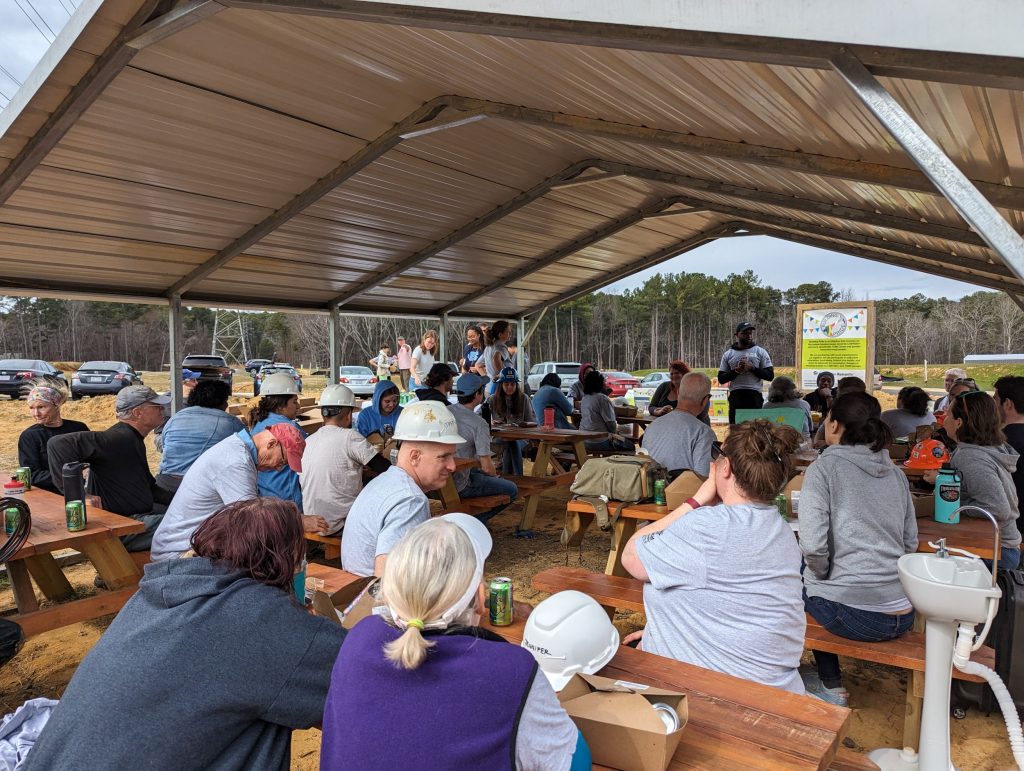
Respect
The day’s goal was not to “change people’s minds.” The goal of Building Pride Day was to educate, raise awareness, and offer space for volunteers to reflect on what “belonging” and “home” mean to them, all while building homes.
There was clear signage, accessible information, and communication about Building Pride at the building site. The Building Pride event had been advertised in e-mails and listservs and communicated ahead of time to volunteers. Still, most volunteers didn’t come mainly for the day’s focus – they came because they loved to serve with Habitat or were interested in serving with Habitat for the first time. And they trusted that whatever Habitat does is valuable. One group did come because of the Building Pride theme – a national organization, Gay for Good, whose Durham chapter brought the most volunteers of any group to the build day. On-site, easy-to-read signs and hand-outs articulated the housing disparities for the LGBTQ community nationwide and precisely in the research triangle.
Lunch dialogue opened with a call to brave space. This was detailed by six principles, communicated at the front of a discussion, and printed for participants.
After a morning of working together, volunteers sat under a covered picnic pavilion with a nourishing lunch to listen to a nurse affiliated with an LGBTQ center in Chapel Hill. The nurse shared accurate information about what holistic health means for transgender people, why it is so hard to achieve for so many, and what those listening could do (learn accurate information and address misinformation if you hear it, to start). The following dialogue prompted tables to address the questions: when did you first feel at home, safe, and part of a community, and how can you offer that welcome to your neighbors? The site lead introduced the idea of a brave space between the presentation and the discussion and shared a copy of six critical points for volunteers.
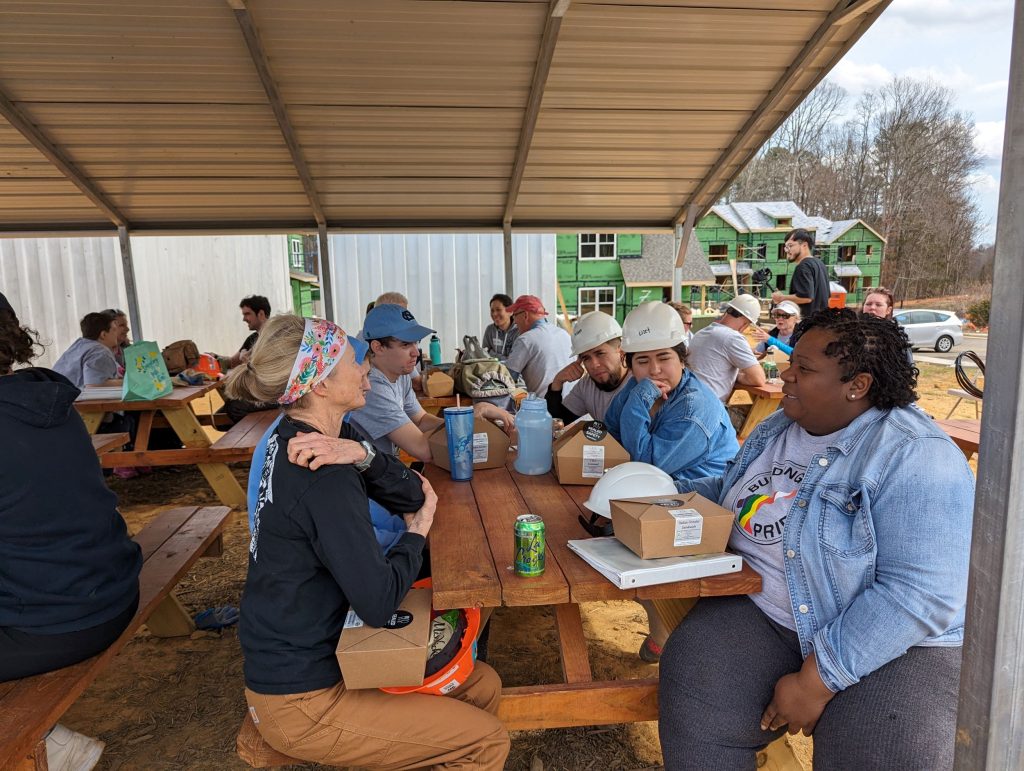
Relate
Volunteers dispersed into groups of 3-4 across the building site, working in small groups with people they didn’t know before.
The build site is broken up into multiple small project groups, each led by a paid construction lead or long-term volunteer who has developed expertise and know-how. Construction leads would ask 3-4 people to follow them and head out to their part of the build. While it was common to see pairs of volunteers head out together, each group ended up with new folks. This allows people to get to know one another around a shared task, to learn about people’s lives, interests, and hobbies, and to develop trust quickly – I may need to count on you to spot me on this ladder!
People could engage at the level they were comfortable with during the lunch session and dialogue, simply listening, asking questions, and sharing in small or large group conversations.
In bridgebuilding work, it is important to acknowledge differences and disagreements, though, at Interfaith America, we don’t encourage starting with the biggest, most thorny challenge first. For an event like Building Pride, where a few people were regulars but many were not, asking open questions that prompt relationships is an essential precursor to digging into differences and disagreements.
There were people at the building who had not learned about the housing needs of the LGBTQ community in the research triangle, and the majority of whom had never heard from a medical expert on the specific needs and ways to support transgender people within and beyond their community. No one was hostile to supporting the LGBTQ community. Some people sat and listened. Some people asked questions. Some people shared their opinions publicly. Some people took a flier, while others did not. Some wore the “Building Pride” t-shirts and took photos before the signage, while others did not. Part of a brave space is being able to voice one’s opinions, questions, and thoughts and not being pigeonholed into one way of thinking.
In small group dialogue, one homeowner shared that “Building Pride” makes sense to her as she grew up with two moms; she is proud to be able to provide a home for her young daughter. In small group dialogue, one longtime volunteer shared that her child told her they were transgender several years ago, and it has taken her some time to learn how and when to share this part of her family with new friends and acquaintances. In a group share out after small group dialogue, one person shared (with permission) on behalf of their table member that they have a nonverbal autistic teenager, and they feel most welcome and most at home with other families with similar family members or in spaces built for them. A great deal was shared to foster relationship and understanding partly because the invitation, the opportunity, and the guidelines were set with care and skill.
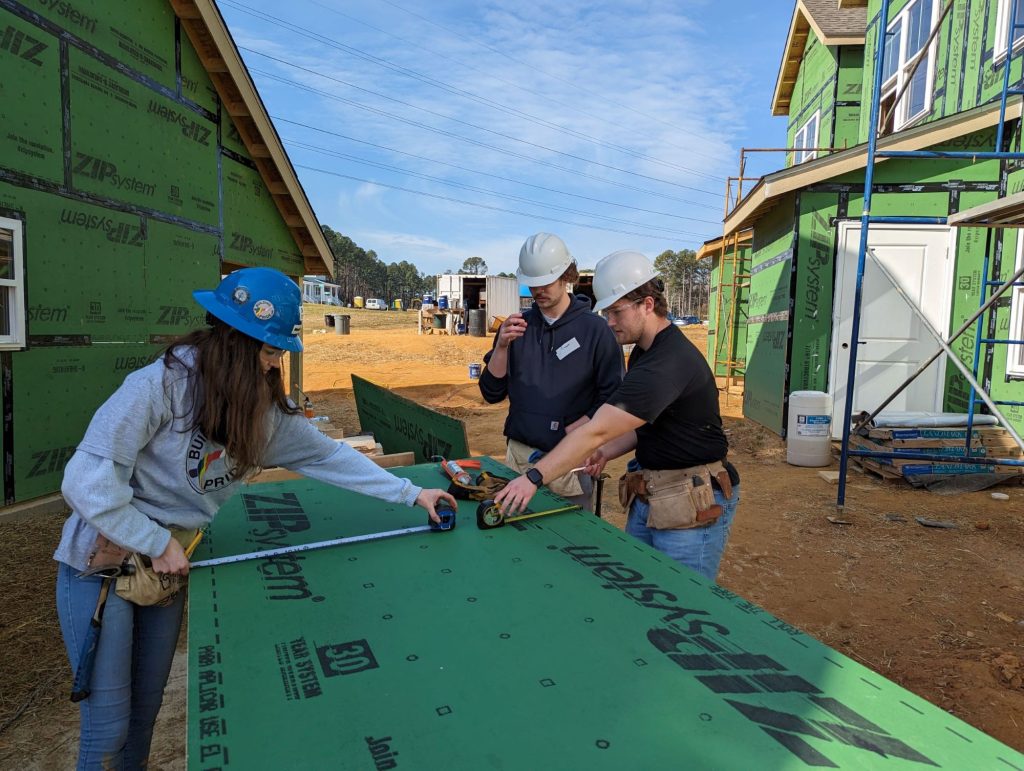
Cooperate
The event met real and pressing needs: the need for affordable housing and the need to raise awareness about the housing and health disparities for the LGBTQ community of the region.
The housing crisis acutely felt across many communities in the U.S. is present for residents in the research triangle. Volunteers are a significant part of building Habitat houses. Volunteers contribute to vital needs in our communities every day, not to mention responding in times of need and crisis. The research-backed insight that diverse teams have better solutions is widely shared (with some preconditions like psychological safety and trust). The reality is that Habitat sites are places where diverse people already come together to serve. Flexing the muscle of learning to listen to others for understanding (not to respond), sharing one’s values and experience, and complexifying participants’ experiences of diverse neighbors enable volunteers to work better together.
According to research shared at the Building Pride event from national organizations and a housing survey, they focused on LGBTQ people, while homeowner rates for non-LGBTQ people are 70%. For the transgender and gender non-conforming (TGNC) community, it is 16%. Homelessness rates across the nation are .18% of the population but 17% of the LGBTQ community and 30% for transgender and gender non-conforming people. The need to address safety, welcome, and shelter for the LGBTQ community is a need in the research triangle. The staff at the local Habitat affiliate recognized the need based on new information and relationships within their office and took a clear step in line with their mission and values to address that need. Without a clear and tangible need, bridgebuilding efforts will likely falter or lose energy.
Habitat for Humanity International – and so many organizations focused on service or cooperation – is well positioned to foster bridgebuilding, particularly for people who wouldn’t already raise their hand to do it. At Orange County Habitat’s Building Pride event, this one affiliate of a major international service organization utilized their organization’s trust and their volunteers’ dedication to respond to a pressing need in their community that, for many, could be a source of division. Their model of Building Pride will be written up in a playbook and available to others to learn from and replicate or adapt on the Team Up website in late spring 2024. Each community’s needs, strengths, and opportunities are particular to that place.
Bridgebuilding happens in a community, often in place, with people whose lives are tied to one another by choice or chance. Interfaith America is proud to partner with Habitat for Humanity International, Catholic Charities USA, and YMCA of the USA to empower these national organizations and inspire many more to Team Up.
Becca Hartman-Pickerill is a Senior Director of Democracy Initiatives at Interfaith America.
We Can Build Bridges
This free, interactive online course shows bridgebuilding in action, defines the goals of bridgebuilding, and gives steps to build bridges in your own life.
